VANTA
VANTA - INFINITY Connect

VANTA Network: A P2P Decentralised Network for Real-time, Secure and Private Connectivity.
The VANTA Network project is backed by Voiceloco, a South Korean company founded in 2013 and the developer of a complete software based IP Multimedia Subsystem (IMS) and Unified Communications as a Service (UCaaS) suite, in use by some of South Korea’s largest conglomerates, including Naver, the #1 search engine of South Korea, Lotte and SK Networks.
The VANTA Network is a permissionless “intelligent network” built on top of the blockchain, consisting of several distinct layers (outlined in detail below), working in combination to deliver a seamless and scalable real time, secure and private method of connecting and communicating. The VANTA Network includes support for legacy communication technology such as, PSTN, SMS, VoIP and PBX/SBC.
Powered by decentralised P2P node infrastructure, the VANTA Networks core value offering is in the reduction of cost and ease of deployment for external parties to build and provision applications via an API/SDK on top of the underlying network/blockchain, with the additional benefits of increased privacy and security in comparison to traditional centralised communication networks.
The VANTA Network technology stack encompasses messaging, file transfer, voice and video call development, large-scale real-time video streaming and transmitting and processing various real-time data collected from IoT sensors.
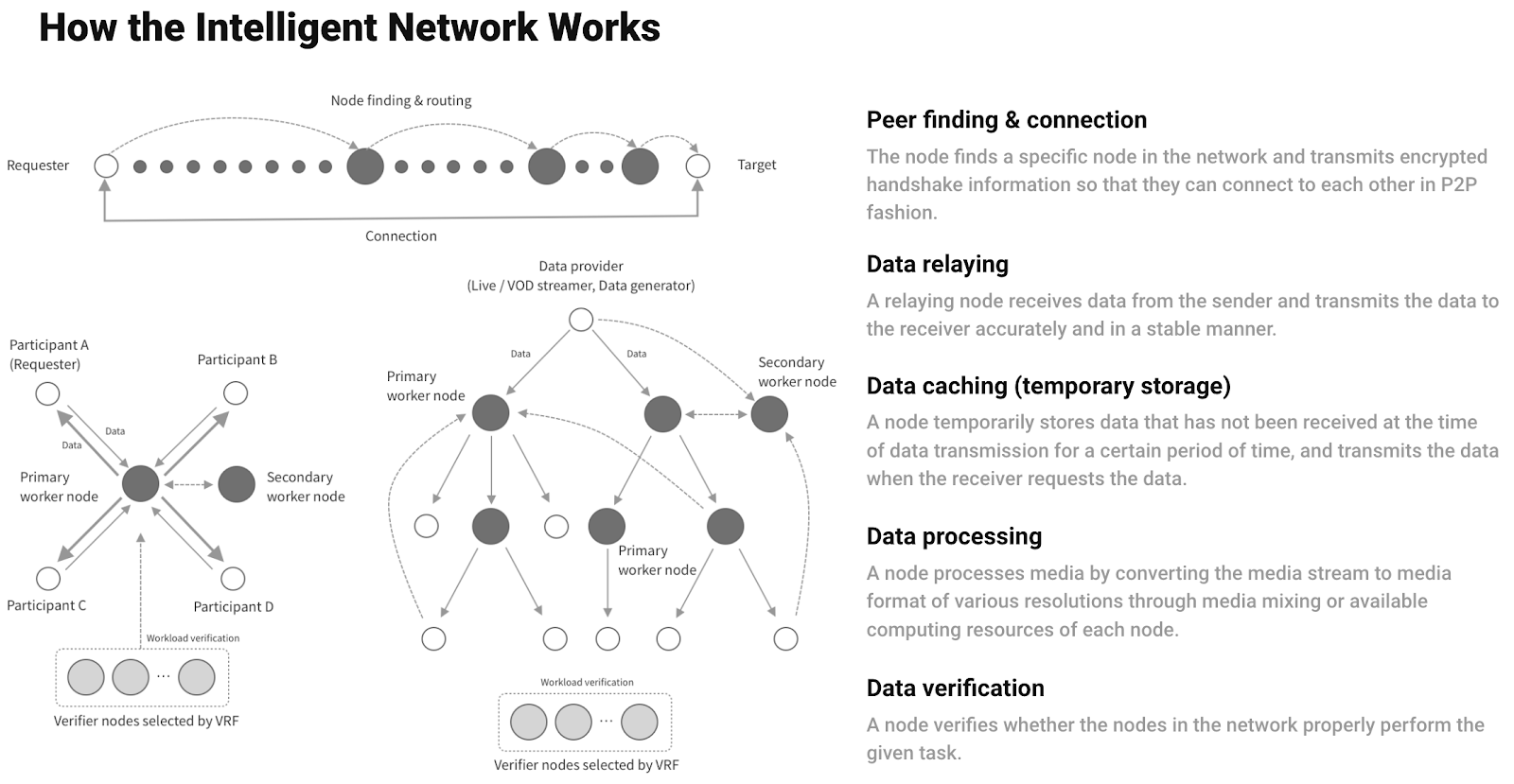
Primary Worker Nodes
This is the node that executes the actual task as soon as the processing of the job starts.
Secondary Worker Nodes
This is the node that waits until the end of the job processing, and when the primary worker node experiences a performance problem during the processing or a network problem occurs, it takes over the task immediately.
Verifier Nodes
Verifer nodes verify if the worker node has been correctly selected and the worker node has properly performed the task for the job. Subsequently, the node issues a proof of the worker node’s workload to the worker node.
Verifer nodes require a lesser amount of staked VNT tokens, and due to their reduced workload, can be run on much lower end devices than worker nodes.

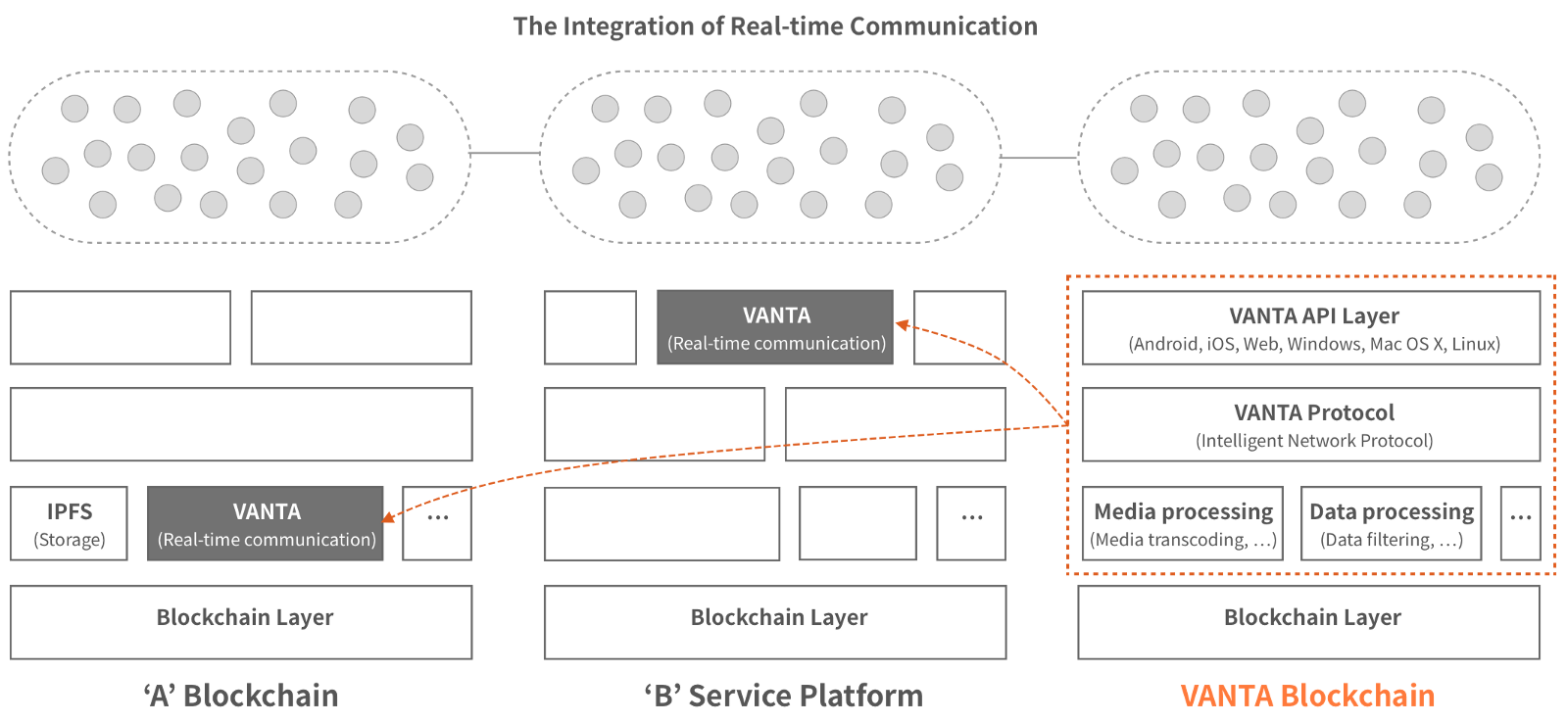
Token Utility
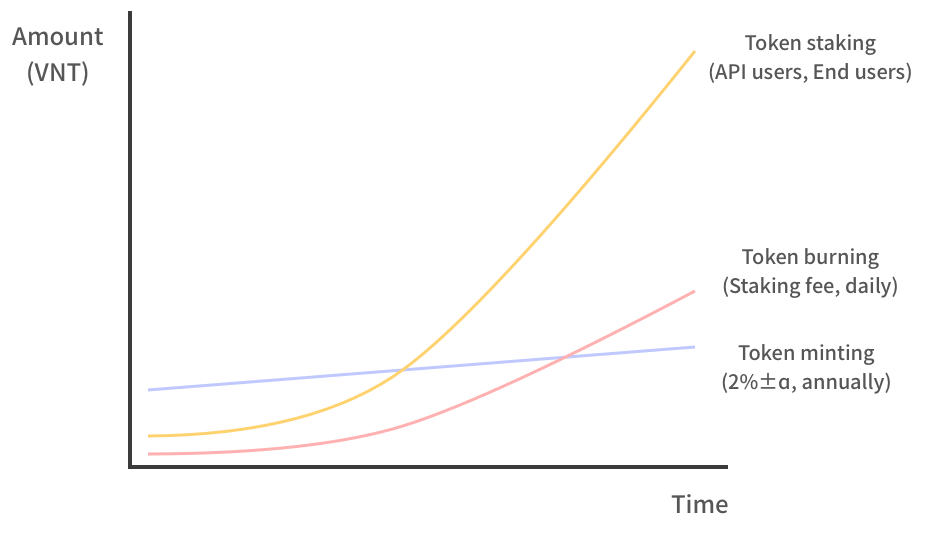
Staking Tokens for API Usage (End Users)

VNT Stake Equation for API Usage (End Users)
In certain cases in which an application developer does not have sufficient funds to continue providing its services, the application has a sudden influx of users requiring more workloads, developers can set staking rules for their end users. When a new user joins the service, or uses the service heavily, a developer can allow the end user to stake the additional amount of tokens required for the developers workload.
The end user can also set a monthly Net usage limit which can enable more user-level custom staking models. Additionally, this way the developer can prevent malicious users to spend the developer’s Net for unintended purposes.
Because of these additional preventative measures, developers can choose to stake all the required Net for all users when they have enough funds.
In the case of startups or individual developers, they can let the users stake the required VNT tokens to operate the service with the community together.
The whitepaper is unclear as to what actual incentive or benefit an end user would gain from staking their own tokens for a developers workload.

Token Metrics
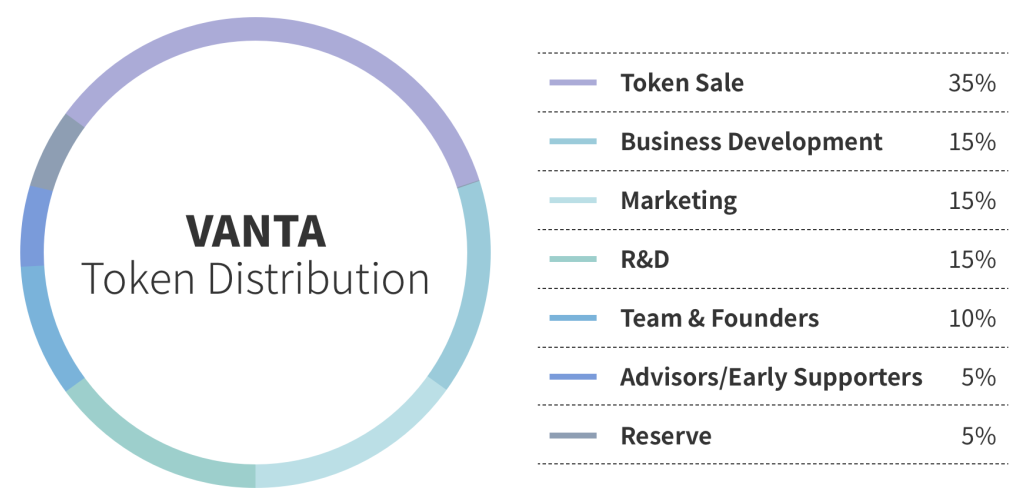
Roadmap

Team
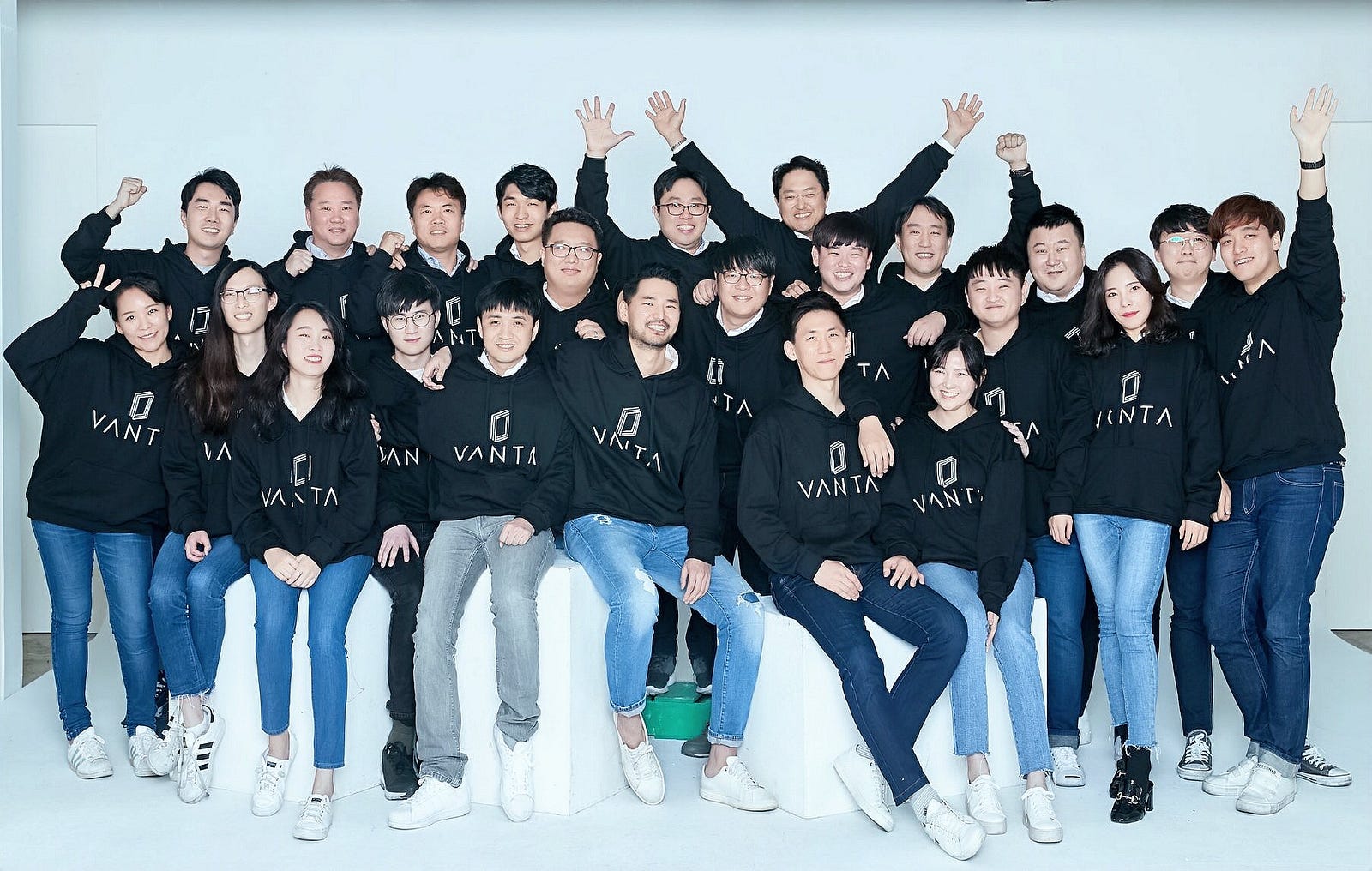
CEO/Founder Ryan Seo
— B.S. Computer Science from Yonsei University
— 12+ years of experience in IT & Telecommunication industry from ORACLE (JAPAC) and HP
Technical Lead Adrian Park
— Master’s Degree from Seoul National University for Computer Vision & Image Processing
— Founded Gamedetect Communications Korea’s very first search engine designed for games in 1999
Data Scientist Martin Jung
— Master’s Degree in Engineering, Industrial Engineering from Yonsei University
— MBA from Carnegie Mellon University
— Technical Analyst/Senior Technical Consultant at Oracle
— Senior Technical Product Manager at Amazon Web Services
Head of R&D Inwhee Joe, Ph.D.
— B.S and M.S in Electrical Engineering from Hanyang University
— M.S in Electrical and Computer Engineering from the University of Arizona
— Ph.D. in Electrical and Computer Engineering from Georgia Institute of Technology
— Professor for the Department of Computer Science at Hanyang University
The VANTA Network core team consists of 26 members, many of whom already work for Voiceloco. A full list of all team members can be found on the VANTA Network website — https://vanta.network/TeamFull

Yoonseok Choi
— Vice President of Microsoft Korea
— Professor at the Computer Engineering Department, Chung-Ang University
Changnam Choi
— Regional Head of Oracle APAC
— M.B.A from the Graduate School of Business at Hanyang University
Henry Chung
— Managing Director at Draper Athena Fund (part of the Draper Investment Network)
— M.S. in Business Administration from Seoul National University
Allie Zhang
— Co-founder of Blocktag
— B.S. in Electrical and Computer Engineering Carnegie Mellon University
Additional information on VANTA’s advisory board can be found in the article below.
VANTA Network Advisory Board
The VANTA Network team is a large one, and one befitting of a platform that has been developed over the course of six years, however it is not immediately apparent as to how much blockchain experience the core team itself has. What is most impressive is the credentials of the executive team and advisory board, with such strong connections to the fintech and academic world, and with such a commercially minded product offering, this bodes well for the future usage and adoption of the product by enterprise in South Korea and beyond.
Partnerships
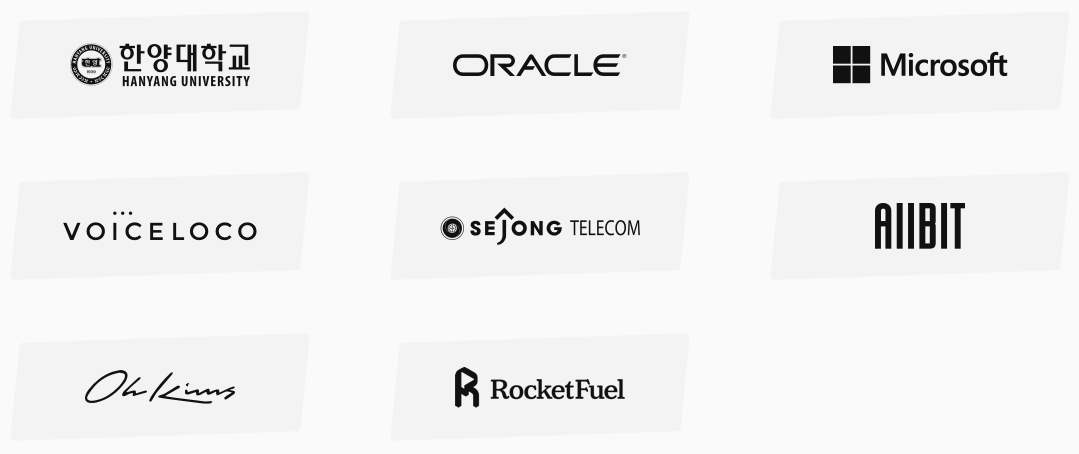
Sejong Telecom
Sejong Telecom is the fourth largest telecom company in Korea. It was established in 1992 and is building a large telecommunication infrastructure in Korea.
VANTA Network will connect the VANTA wallet and user accounts to existing traditional phone numbers via the partnership with Sejong Telecom.
Allbit
Allbit is a subsidiary of UPbit, one of South Korea’s largest exchanges. One would expect with such an exchange partnership the VANTA Network IEO should be well supported and that future exchange listings, paired to KRW, will be forthcoming.
RocketFuel
RocketFuel consists of top minds from cutting-edge companies such as Snapchat, Uber, Airbnb, Accenture, McKinsey and more.
RocketFuel have previously taken a stake in blockchain projects such as Chromapolis, Allbit, ICON, VeChain, Bluzelle and Chainlink, among others.
Hanyang University
This collaboration is with the MNI (Mobile & Network Intelligence) Lab and involves collaboration on research into consensus and data routing algorithms in addition to supporting the development and validation of PoC models.
Summary
The main points of interest in the VANTA Network are all related to its connection back to the South Korean tech and crypto scenes. While the tech offering is a strong one, with backing from an existing company with a long term and widely used communication platform who have extremely strong connections back to tech and academic behemoths, with the delivery of mainnet being some time off, it would be prudent to take a shorter term approach to the project in it’s initial stage to see if it replicates some of the success enjoyed by other South Korean IEO’s.
More Information Visit The VANTA Link:
==============================================
Website : https://vanta.network/
ANN Thread : https://bitcointalk.org/index.php?topic=5095100
Twitter : https://twitter.com/vantanetwork
Facebook : https://www.facebook.com/vantanetwork/
Telegram : https://t.me/vantanetwork
Reddit : https://www.reddit.com/r/vantanetwork/
==============================================

Hello everyone, readers of my blog Syndrome ICO. I will explain a bit about the crypto currency project, This is most relevant in the world of crypto currency, which is characterized by its high volatility. I decided to look for a project where all the tools for productive, high-quality and profitable trading by crypto-currencies will gather. And this is the VANTA project.
The VANTA Network project is backed by Voiceloco, a South Korean company founded in 2013 and the developer of a complete software based IP Multimedia Subsystem (IMS) and Unified Communications as a Service (UCaaS) suite, in use by some of South Korea’s largest conglomerates, including Naver, the #1 search engine of South Korea, Lotte and SK Networks.
The VANTA Network is a permissionless “intelligent network” built on top of the blockchain, consisting of several distinct layers (outlined in detail below), working in combination to deliver a seamless and scalable real time, secure and private method of connecting and communicating. The VANTA Network includes support for legacy communication technology such as, PSTN, SMS, VoIP and PBX/SBC.
Powered by decentralised P2P node infrastructure, the VANTA Networks core value offering is in the reduction of cost and ease of deployment for external parties to build and provision applications via an API/SDK on top of the underlying network/blockchain, with the additional benefits of increased privacy and security in comparison to traditional centralised communication networks.
The VANTA Network technology stack encompasses messaging, file transfer, voice and video call development, large-scale real-time video streaming and transmitting and processing various real-time data collected from IoT sensors.

The VANTA Network Intelligent Design
In the blockchain space, VANTA Network is positioned at a base level (with several major points of difference) to compete with two other communication based blockchain projects, Mainframe and Skrumble Network. As per these other projects (Mainframe and ONYX and Skrumble Network and Ally), VANTA will release a DApp of their existing centralised application, Ciao, once their mainnet is released.
In the traditional application space, the VANTA Network directly competes with the likes of Slack, Twilio and other collaborative communication tools, however due to the API/SDK and the ability to leverage the underlying VANTA network and blockchain, also extends out to other niches such as video streaming, gaming and the Internet of Things.
A brief introduction to the VANTA Network, as published by the team themselves, can be seen in the article below.
The VANTA Network

In the blockchain space, VANTA Network is positioned at a base level (with several major points of difference) to compete with two other communication based blockchain projects, Mainframe and Skrumble Network. As per these other projects (Mainframe and ONYX and Skrumble Network and Ally), VANTA will release a DApp of their existing centralised application, Ciao, once their mainnet is released.
In the traditional application space, the VANTA Network directly competes with the likes of Slack, Twilio and other collaborative communication tools, however due to the API/SDK and the ability to leverage the underlying VANTA network and blockchain, also extends out to other niches such as video streaming, gaming and the Internet of Things.
A brief introduction to the VANTA Network, as published by the team themselves, can be seen in the article below.
The VANTA Network

VANTA Network Architecture
The VANTA Network infrastructure consists of four main layers.
1— The Blockchain Layer (KANUS)
The VANTA Network combines Proof of Networking (PoN)with Byzantine Fault Tolerance (BFT) and Verifiable Random Functions (VRF) to form a bespoke PoN-VRBFT consensus algorithm. Quite a mouthful right? BFT and VRF have previously been used in combination on projects such as Algorandand Ontology, however those projects combined Proof of Stake (PoS) with BFT and VRF, whereas the VANTA Network uses PoN in combination with those two methods instead.
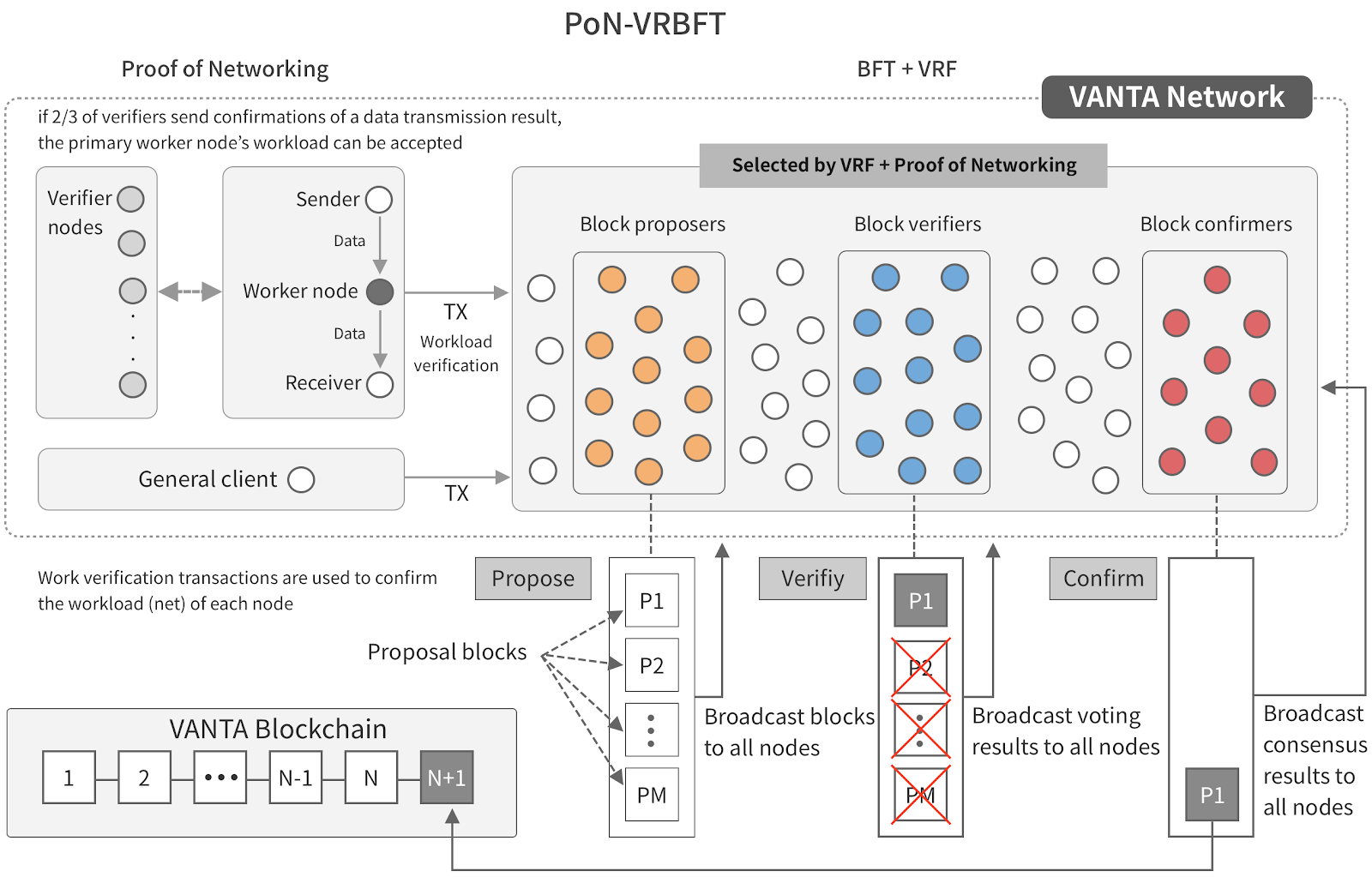
The VANTA Network infrastructure consists of four main layers.
1— The Blockchain Layer (KANUS)
The VANTA Network combines Proof of Networking (PoN)with Byzantine Fault Tolerance (BFT) and Verifiable Random Functions (VRF) to form a bespoke PoN-VRBFT consensus algorithm. Quite a mouthful right? BFT and VRF have previously been used in combination on projects such as Algorandand Ontology, however those projects combined Proof of Stake (PoS) with BFT and VRF, whereas the VANTA Network uses PoN in combination with those two methods instead.

VANTA Network Consensus Algorithm
Proof of Networking (PoN)
Proof of Networking is an algorithm that mandates each node that has contributed competitively for live data communication, processing and storage to prove their workload and use that proof data when participating in a consensus round. The workload of each node is verified by verifier nodes selected through VRF, and recorded using VANTA’s unique workload unit called net and net price to prove the amount of workload and the actual value
of it. This is what differentiates Proof of Networking from other consensus algorithms.
Proof of Networking is an algorithm that mandates each node that has contributed competitively for live data communication, processing and storage to prove their workload and use that proof data when participating in a consensus round. The workload of each node is verified by verifier nodes selected through VRF, and recorded using VANTA’s unique workload unit called net and net price to prove the amount of workload and the actual value
of it. This is what differentiates Proof of Networking from other consensus algorithms.
Byzantine Fault Tolerance (BFT)
In a P2P network, a consensus is achieved if the loyal, or non-faulty nodes, achieve a unanimous agreement on their decision. Byzantine Fault Tolerance means an incoming message is repeated to other recipients of that incoming message. All of the nodes make the assumption that the act of repeating a message rules out the issue of Byzantine nodes.
In a P2P network, a consensus is achieved if the loyal, or non-faulty nodes, achieve a unanimous agreement on their decision. Byzantine Fault Tolerance means an incoming message is repeated to other recipients of that incoming message. All of the nodes make the assumption that the act of repeating a message rules out the issue of Byzantine nodes.
Verifiable Random Functions (VRF)
A Verifiable Random Function (VRF) is a pseudo-random function that provides proof that can be used to publicly verify the accuracy of its output. It is widely used within VANTA’s real-time networking job competition model and blockchain consensus algorithm. By using VRF VANTA Network is able to reduce the times nodes have to communicate with each other to reach consensus, allowing blocks to be generated at a much faster speed.
Essentially this consensus algorithm has been developed, and is required due to the real time nature of the data being passed across the network. By combining the three concepts this improves the security, scalability and transaction speed of existing consensus algorithms, allowing the VANTA Network to process data at the necessary speeds required for “real-time” data delivery.
The VANTA Network is powered by a series of P2P nodes. Users can download the VANTA core client on a computer or mobile device, stake VNT tokens and participate in the VANTA Network by processing workloads. Certain applications released on the VANTA Network will also give users the ability to actively participate in the network. Nodes that are selected and process workloads are eligible for a portion of the block reward, based off their contribution to the workload itself (the specifics of which are covered in more detail in the Token Utility section below).
There are currently no guidelines as to how many VNT tokens are required to stake at each node level, or the hardware requirements in order to run each type of node.
Job Tracker Nodes
The first node to receive a job request from a requester node becomes the job tracker. The job tracker is valid only for the job request. Job trackers are responsible for verifying and broadcasting job requests, managing nodes selected to process jobs, connecting existing workers and requesters and more. Job trackers also submit job transactions.
A Verifiable Random Function (VRF) is a pseudo-random function that provides proof that can be used to publicly verify the accuracy of its output. It is widely used within VANTA’s real-time networking job competition model and blockchain consensus algorithm. By using VRF VANTA Network is able to reduce the times nodes have to communicate with each other to reach consensus, allowing blocks to be generated at a much faster speed.
Essentially this consensus algorithm has been developed, and is required due to the real time nature of the data being passed across the network. By combining the three concepts this improves the security, scalability and transaction speed of existing consensus algorithms, allowing the VANTA Network to process data at the necessary speeds required for “real-time” data delivery.
The VANTA Network is powered by a series of P2P nodes. Users can download the VANTA core client on a computer or mobile device, stake VNT tokens and participate in the VANTA Network by processing workloads. Certain applications released on the VANTA Network will also give users the ability to actively participate in the network. Nodes that are selected and process workloads are eligible for a portion of the block reward, based off their contribution to the workload itself (the specifics of which are covered in more detail in the Token Utility section below).
There are currently no guidelines as to how many VNT tokens are required to stake at each node level, or the hardware requirements in order to run each type of node.
Job Tracker Nodes
The first node to receive a job request from a requester node becomes the job tracker. The job tracker is valid only for the job request. Job trackers are responsible for verifying and broadcasting job requests, managing nodes selected to process jobs, connecting existing workers and requesters and more. Job trackers also submit job transactions.
Primary Worker Nodes
This is the node that executes the actual task as soon as the processing of the job starts.
Secondary Worker Nodes
This is the node that waits until the end of the job processing, and when the primary worker node experiences a performance problem during the processing or a network problem occurs, it takes over the task immediately.
Verifier Nodes
Verifer nodes verify if the worker node has been correctly selected and the worker node has properly performed the task for the job. Subsequently, the node issues a proof of the worker node’s workload to the worker node.
Verifer nodes require a lesser amount of staked VNT tokens, and due to their reduced workload, can be run on much lower end devices than worker nodes.

How Jobs Are Assigned/Completed on the VANTA Network
2— The Core Layer
The core module of the ARKAS protocol, the implementation of the main functions that peers perform within the network.
3 — The Protocol Layer (ARKAS)
A protocol that enables peers to build the VANTA’s intelligent network. The ARKAS protocol allows for peers to perform real-time data transmission, processing and storing by selecting and evaluating peers. It is an evolving network that strengthens the scalability, reliability, efficiency, and privacy of real-time networking by creating a competitive system based on resources such as computing power, network bandwidth and reliability.

2— The Core Layer
The core module of the ARKAS protocol, the implementation of the main functions that peers perform within the network.
3 — The Protocol Layer (ARKAS)
A protocol that enables peers to build the VANTA’s intelligent network. The ARKAS protocol allows for peers to perform real-time data transmission, processing and storing by selecting and evaluating peers. It is an evolving network that strengthens the scalability, reliability, efficiency, and privacy of real-time networking by creating a competitive system based on resources such as computing power, network bandwidth and reliability.

VANTA Network Protocol Layer Encryption Example
4 — The API Layer
The API layer is the layer in which companies or users are able to connect external services/applications to the VANTA Network by using the VANTA API and SDK.
API users are required to stake VNT tokens to use the API, which allows full access to network services, such as the transfer, processing and storage of data on and across the VANTA Network. Additionally API users are required to stake VNT tokens to use network resources (known as workloads). When unstaking tokens 2% of the staked tokens will be charged as a fee and those tokens will be burnt.
4 — The API Layer
The API layer is the layer in which companies or users are able to connect external services/applications to the VANTA Network by using the VANTA API and SDK.
API users are required to stake VNT tokens to use the API, which allows full access to network services, such as the transfer, processing and storage of data on and across the VANTA Network. Additionally API users are required to stake VNT tokens to use network resources (known as workloads). When unstaking tokens 2% of the staked tokens will be charged as a fee and those tokens will be burnt.

VANTA Network Modular Approach
VANTA have identified five main use cases for the VANTA Network.

VANTA have identified five main use cases for the VANTA Network.

VANTA Network Use Cases
1 — Communications

1 — Communications

Voiceloco Ciao Application
The Voiceloco Ciao application doubles as the VANTA Network MVP. The Ciao application will be the first DApp available on the VANTA Network. Once available, Voiceloco will begin to port over users from the centralised version of the app to the decentralised version.
The Ciao App can be downloaded on Android and iOS as well being accessible as a web application. A desktop version for PC and MacOS is coming soon.
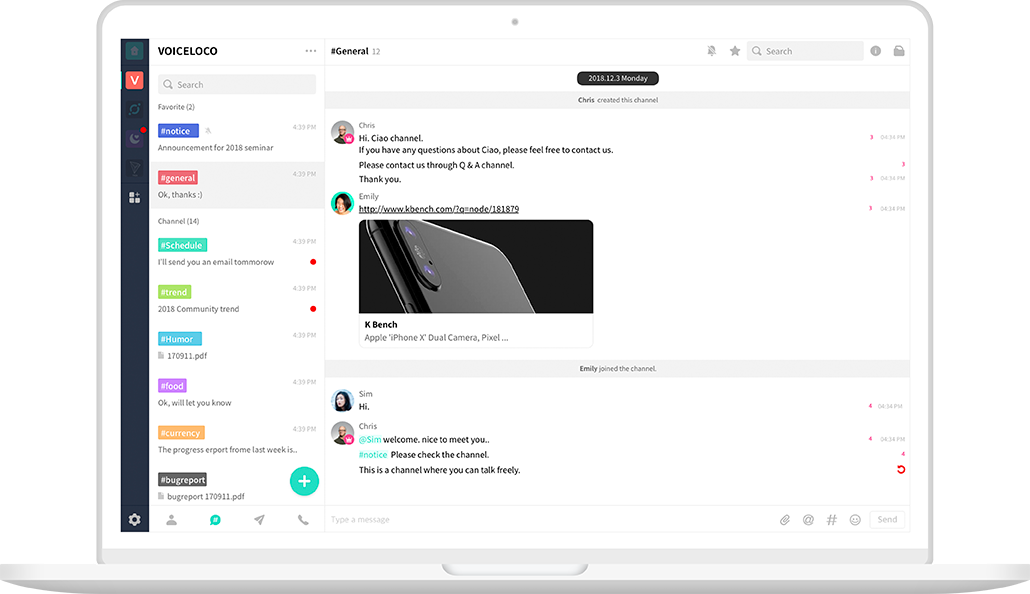
The Voiceloco Ciao application doubles as the VANTA Network MVP. The Ciao application will be the first DApp available on the VANTA Network. Once available, Voiceloco will begin to port over users from the centralised version of the app to the decentralised version.
The Ciao App can be downloaded on Android and iOS as well being accessible as a web application. A desktop version for PC and MacOS is coming soon.

Ciao App — Channels






Ciao App Screens
Further communication platforms that could utilise the VANTA Network include real-time collaboration services, delivery/shopping/car sharing/reservation services and social dating services.

Further communication platforms that could utilise the VANTA Network include real-time collaboration services, delivery/shopping/car sharing/reservation services and social dating services.

VANTA Network Communication API Usage
2 — Video Streaming
VANTA Network Video Streaming Use Case
The VANTA Network allows for simple and low cost creation of P2P live or VOD streaming services and looks to tap into the growing online, real time video streaming market.

2 — Video Streaming
VANTA Network Video Streaming Use Case
The VANTA Network allows for simple and low cost creation of P2P live or VOD streaming services and looks to tap into the growing online, real time video streaming market.

VANTA Network Streaming Market Opportunity
Live video streaming services include online courses, user-generated
video content, sports & game broadcasts among others, while VOD streaming services include movies, entertainment, and music.
3 — Gaming
VANTA Network Gaming Use Case
Through the P2P-based real-time data transfer function provided by the VANTA network, developers can easily develop a multiplayer game at low cost only by developing a game client, and the player’s game data required for the game progress can be generated by using the VANTA SDK to the client of the player of the game server.
Tradable items with monetary value can also be tracked by the VANTA Network’s blockchain.
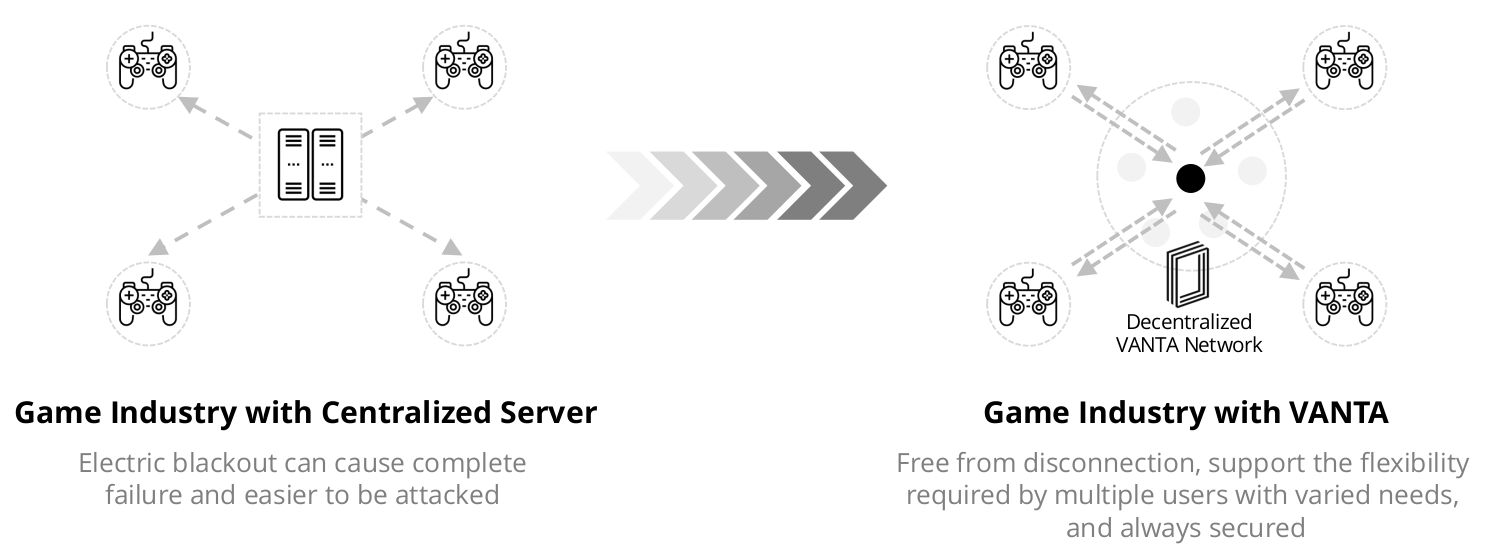
Live video streaming services include online courses, user-generated
video content, sports & game broadcasts among others, while VOD streaming services include movies, entertainment, and music.
3 — Gaming
VANTA Network Gaming Use Case
Through the P2P-based real-time data transfer function provided by the VANTA network, developers can easily develop a multiplayer game at low cost only by developing a game client, and the player’s game data required for the game progress can be generated by using the VANTA SDK to the client of the player of the game server.
Tradable items with monetary value can also be tracked by the VANTA Network’s blockchain.

Game Deployment, Traditional vs VANTA Network
4 — IoT
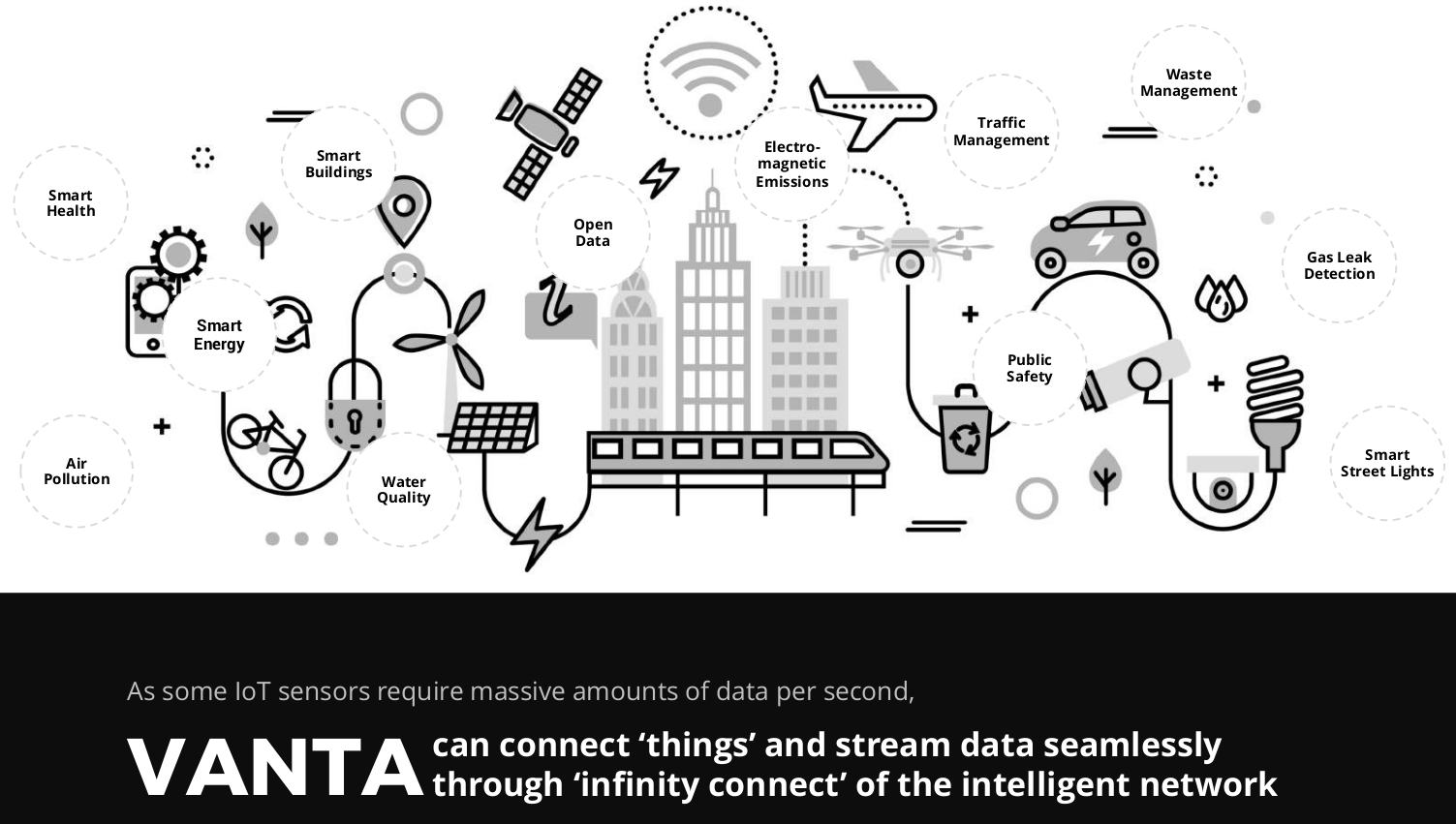
4 — IoT

VANTA Network IoT Use Case
Some IoT sensors and hubs require thousands to tens of thousands of data per second. These IoT sensors and hubs can use the VANTA Network to process traffic data, factory operation data, personalized medical and welfare data, connected car data, smart home data etc.
5 — Collaboration
Collaboration, from our understanding, is closely related with the VANTA Network partnerships with Microsoft and Oracle in regards to attracting and working with existing technology partners to expose the VANTA Network to an existing enterprise client base.
Some IoT sensors and hubs require thousands to tens of thousands of data per second. These IoT sensors and hubs can use the VANTA Network to process traffic data, factory operation data, personalized medical and welfare data, connected car data, smart home data etc.
5 — Collaboration
Collaboration, from our understanding, is closely related with the VANTA Network partnerships with Microsoft and Oracle in regards to attracting and working with existing technology partners to expose the VANTA Network to an existing enterprise client base.
Token Utility

VNT Token Velocity
In the VANTA Network token economy, past initially issued tokens, new tokens are minted annually at a rate of 2% plus or minus the variable rate of the number of tokens burnt in the previous year. This percentage of tokens as designated as the available tokens for block rewards given to nodes for participating in the workload and delivery of network services.
As such, the block reward on the VANTA Network is variable, not fixed, and is based off the amount of workloads that have been performed and validated across the network. The following equation details the compensation received by a node on the VANTA Network.
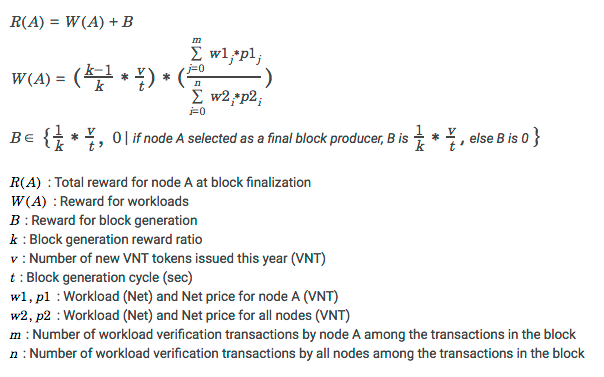
In the VANTA Network token economy, past initially issued tokens, new tokens are minted annually at a rate of 2% plus or minus the variable rate of the number of tokens burnt in the previous year. This percentage of tokens as designated as the available tokens for block rewards given to nodes for participating in the workload and delivery of network services.
As such, the block reward on the VANTA Network is variable, not fixed, and is based off the amount of workloads that have been performed and validated across the network. The following equation details the compensation received by a node on the VANTA Network.

VANTA Network Block Reward Equation
While tokens are given to nodes for performing workloads, penalties also apply for nodes who do not fulfill their obligations as participants in the network (failure to complete or deliver a job/failure to transmit required data/failure to deliver consensus).
Staking Tokens for Nodes
The VANTA Network has several tiers of nodes, Job Tracker Nodes, Primary Worker Nodes, Secondary Worker Nodes and Verifier Nodes, all of whom are eligible for block rewards when actively participating in the network by processing assigned workloads.
As previously mentioned, verifier nodes are able to be run on lower end devices and require a lesser stake of VNT.
There are currently no guidelines published by the VANTA Network team as to how many VNT tokens are required for each node tier.
Staking Tokens for API Usage (Application Developers)
For a user or company to build on top of the VANTA Network and leverage the API, thus enabling the transfer, processing, and storage of data on the VANTA Network, a stake of VNT tokens is required. The amount of VNT required as stake is determined by the following equation.
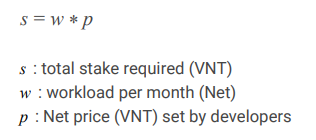
VNT Stake Equation for API Usage (Application Developers)
The whitepaper provides an example of such a scenario —
If an application developer needs a 500,000-net total of real-time networking resources per month for their application and the current average net price is 3 VNTs, the developer can set the net price to 3 VNTs and stake a total of 1,500,000 VNTs (500,000 net * 3 VNTs). If the developer wants the jobs submitted by their service to be processed faster or want it to be processed by nodes with higher performance, setting a higher Net price will prioritize processing for that job on the network.
When the application generates a job request and the work to be processed by the job is worth 20 Net, 60 VNT (20 Net * 3 VNTs) is set as the price of the job and propagated to the network. Then, the nodes that are willing to process the job for the price will competitively participate and process real-time data transmitting, processing, and storing etc. 20 Net out of 500,000 Net for the developer’s service will be deducted for the job from its available workload request, and 20 Net will be filled to its available workload after 30 days.
While tokens are given to nodes for performing workloads, penalties also apply for nodes who do not fulfill their obligations as participants in the network (failure to complete or deliver a job/failure to transmit required data/failure to deliver consensus).
Staking Tokens for Nodes
The VANTA Network has several tiers of nodes, Job Tracker Nodes, Primary Worker Nodes, Secondary Worker Nodes and Verifier Nodes, all of whom are eligible for block rewards when actively participating in the network by processing assigned workloads.
As previously mentioned, verifier nodes are able to be run on lower end devices and require a lesser stake of VNT.
There are currently no guidelines published by the VANTA Network team as to how many VNT tokens are required for each node tier.
Staking Tokens for API Usage (Application Developers)
For a user or company to build on top of the VANTA Network and leverage the API, thus enabling the transfer, processing, and storage of data on the VANTA Network, a stake of VNT tokens is required. The amount of VNT required as stake is determined by the following equation.

VNT Stake Equation for API Usage (Application Developers)
The whitepaper provides an example of such a scenario —
If an application developer needs a 500,000-net total of real-time networking resources per month for their application and the current average net price is 3 VNTs, the developer can set the net price to 3 VNTs and stake a total of 1,500,000 VNTs (500,000 net * 3 VNTs). If the developer wants the jobs submitted by their service to be processed faster or want it to be processed by nodes with higher performance, setting a higher Net price will prioritize processing for that job on the network.
When the application generates a job request and the work to be processed by the job is worth 20 Net, 60 VNT (20 Net * 3 VNTs) is set as the price of the job and propagated to the network. Then, the nodes that are willing to process the job for the price will competitively participate and process real-time data transmitting, processing, and storing etc. 20 Net out of 500,000 Net for the developer’s service will be deducted for the job from its available workload request, and 20 Net will be filled to its available workload after 30 days.
Staking Tokens for API Usage (End Users)

VNT Stake Equation for API Usage (End Users)
In certain cases in which an application developer does not have sufficient funds to continue providing its services, the application has a sudden influx of users requiring more workloads, developers can set staking rules for their end users. When a new user joins the service, or uses the service heavily, a developer can allow the end user to stake the additional amount of tokens required for the developers workload.
The end user can also set a monthly Net usage limit which can enable more user-level custom staking models. Additionally, this way the developer can prevent malicious users to spend the developer’s Net for unintended purposes.
Because of these additional preventative measures, developers can choose to stake all the required Net for all users when they have enough funds.
In the case of startups or individual developers, they can let the users stake the required VNT tokens to operate the service with the community together.
The whitepaper is unclear as to what actual incentive or benefit an end user would gain from staking their own tokens for a developers workload.

VANTA Network Staking Model Scenarios
Burning Tokens as API fees
As per the above, developers must stake VNT tokens to ensure that their services run on VANTA. Depending on the developers and their policies, participants/users may be required to stake VNT tokens as well. When staking and unstaking tokens to purchase a workload, VANTA generates a 2% fee of the staked amount and these tokens are immediately burned.
As more applications and services are hosted on the VANTA Network, the staking/unstaking process will occur more frequently and as such the amount of burnt tokens will also increase. This has the dual effect of both locking tokens from the overall circulating supply, while also reducing the overall circulating supply via burnt tokens.

As per the above, developers must stake VNT tokens to ensure that their services run on VANTA. Depending on the developers and their policies, participants/users may be required to stake VNT tokens as well. When staking and unstaking tokens to purchase a workload, VANTA generates a 2% fee of the staked amount and these tokens are immediately burned.
As more applications and services are hosted on the VANTA Network, the staking/unstaking process will occur more frequently and as such the amount of burnt tokens will also increase. This has the dual effect of both locking tokens from the overall circulating supply, while also reducing the overall circulating supply via burnt tokens.

VANTA Network Cryptoeconomics
Token Metrics

VANTA Network Token Metrics
The VANTA Network project has a hardcap of 15m USD and is currently in the private sale stage. The private sale includes a 15% bonus on an initial token price of $0.00088 USD. From the total 15m USD hardcap, 12.2m USD is available to the private sale with 2.8m USD allocated to the public sale. It is currently unclear if the IEO will consist of only the 2.8m USD allocated to the public sale.
A total of 56,200,000,000 (56.2 billion) VNT tokens will be issued. 35% of these tokens will be sold during the IEO. The IEO is expected to launch in early January on several South Korean exchanges.
50% of purchased tokens will have no lockup and will be available immediately after purchase. The remaining 50% of purchased tokens will attract a one month lockup. For those who contribute during the private sale and receive the 15% extra bonus tokens, these will be locked for two months.
10% of tokens are allocated to the Team/Founders and are locked for two years. The 5% of Advisor/Early Supporter tokens are locked for one year.
Tokens will be issued as ERC20 placeholder tokens and will be exchangeable for mainnet tokens once mainnet is released in Q3 2019, however ERC20 tokens will be immediately tradable after the IEO on the issuing exchanges.
The ERC20 VNT token will have a KRW trading pair from day one.
Post IEO, the circulating supply should be approximately 10,950,609,091 (10.9 billion) VNT (approx 19% of overall supply).
Unsold tokens from the token sale will be burnt. Tokens burnt will be sent to the VNT zero address.
The VANTA Network project has a hardcap of 15m USD and is currently in the private sale stage. The private sale includes a 15% bonus on an initial token price of $0.00088 USD. From the total 15m USD hardcap, 12.2m USD is available to the private sale with 2.8m USD allocated to the public sale. It is currently unclear if the IEO will consist of only the 2.8m USD allocated to the public sale.
A total of 56,200,000,000 (56.2 billion) VNT tokens will be issued. 35% of these tokens will be sold during the IEO. The IEO is expected to launch in early January on several South Korean exchanges.
50% of purchased tokens will have no lockup and will be available immediately after purchase. The remaining 50% of purchased tokens will attract a one month lockup. For those who contribute during the private sale and receive the 15% extra bonus tokens, these will be locked for two months.
10% of tokens are allocated to the Team/Founders and are locked for two years. The 5% of Advisor/Early Supporter tokens are locked for one year.
Tokens will be issued as ERC20 placeholder tokens and will be exchangeable for mainnet tokens once mainnet is released in Q3 2019, however ERC20 tokens will be immediately tradable after the IEO on the issuing exchanges.
The ERC20 VNT token will have a KRW trading pair from day one.
Post IEO, the circulating supply should be approximately 10,950,609,091 (10.9 billion) VNT (approx 19% of overall supply).
Unsold tokens from the token sale will be burnt. Tokens burnt will be sent to the VNT zero address.
Roadmap

VANTA Network Roadmap
The VANTA Network was formally established in Q2 2018, however the non blockchain tech that sits behind the VANTA Network originates from the formation of Voiceloco in 2013.
Q1 2019 marks the release of the technical whitepaper and development of the ARKAS protocol. The IEO will also be launched in January. It’s unclear if the technical whitepaper will be released before the IEO.
The VANTA Network testnet will be delivered in Q2 2019 with mainnet following in Q3 2019, which includes the VNT token swap from ERC20 VNT to native tokens.
2020 focuses on the expansion of DApp development on top of the VANTA Network for external parties.
While a TGE closer to a mainnet release is always preferred, and in VANTA Networks case is quite some time off, due to other factors surrounding the project, the South Korean angle, an IEO instead of an ICO and an immediate ERC20 token listing with a KRW pairing, has resulted in this project still gaining our attention…in the short term at least.
The VANTA Network was formally established in Q2 2018, however the non blockchain tech that sits behind the VANTA Network originates from the formation of Voiceloco in 2013.
Q1 2019 marks the release of the technical whitepaper and development of the ARKAS protocol. The IEO will also be launched in January. It’s unclear if the technical whitepaper will be released before the IEO.
The VANTA Network testnet will be delivered in Q2 2019 with mainnet following in Q3 2019, which includes the VNT token swap from ERC20 VNT to native tokens.
2020 focuses on the expansion of DApp development on top of the VANTA Network for external parties.
While a TGE closer to a mainnet release is always preferred, and in VANTA Networks case is quite some time off, due to other factors surrounding the project, the South Korean angle, an IEO instead of an ICO and an immediate ERC20 token listing with a KRW pairing, has resulted in this project still gaining our attention…in the short term at least.
Team

Some of the VANTA Network Team
The VANTA Network team consists of 34 members in total, 4 executives/management, 26 core team members and 4 advisors. The team is structured as three separate units, the management team, tech team and the research team.

The VANTA Network team consists of 34 members in total, 4 executives/management, 26 core team members and 4 advisors. The team is structured as three separate units, the management team, tech team and the research team.

VANTA Network Executive Team
CEO/Founder Ryan Seo
— B.S. Computer Science from Yonsei University
— 12+ years of experience in IT & Telecommunication industry from ORACLE (JAPAC) and HP
Technical Lead Adrian Park
— Master’s Degree from Seoul National University for Computer Vision & Image Processing
— Founded Gamedetect Communications Korea’s very first search engine designed for games in 1999
Data Scientist Martin Jung
— Master’s Degree in Engineering, Industrial Engineering from Yonsei University
— MBA from Carnegie Mellon University
— Technical Analyst/Senior Technical Consultant at Oracle
— Senior Technical Product Manager at Amazon Web Services
Head of R&D Inwhee Joe, Ph.D.
— B.S and M.S in Electrical Engineering from Hanyang University
— M.S in Electrical and Computer Engineering from the University of Arizona
— Ph.D. in Electrical and Computer Engineering from Georgia Institute of Technology
— Professor for the Department of Computer Science at Hanyang University
The VANTA Network core team consists of 26 members, many of whom already work for Voiceloco. A full list of all team members can be found on the VANTA Network website — https://vanta.network/TeamFull

VANTA Network Core Team
Additional information on VANTA’s core development team can be found in the article below.
The VANTA Network advisory board consists of several names of note in the South Korean tech and blockchain scene.
Additional information on VANTA’s core development team can be found in the article below.
The VANTA Network advisory board consists of several names of note in the South Korean tech and blockchain scene.
Yoonseok Choi
— Vice President of Microsoft Korea
— Professor at the Computer Engineering Department, Chung-Ang University
Changnam Choi
— Regional Head of Oracle APAC
— M.B.A from the Graduate School of Business at Hanyang University
Henry Chung
— Managing Director at Draper Athena Fund (part of the Draper Investment Network)
— M.S. in Business Administration from Seoul National University
Allie Zhang
— Co-founder of Blocktag
— B.S. in Electrical and Computer Engineering Carnegie Mellon University
Additional information on VANTA’s advisory board can be found in the article below.
VANTA Network Advisory Board
The VANTA Network team is a large one, and one befitting of a platform that has been developed over the course of six years, however it is not immediately apparent as to how much blockchain experience the core team itself has. What is most impressive is the credentials of the executive team and advisory board, with such strong connections to the fintech and academic world, and with such a commercially minded product offering, this bodes well for the future usage and adoption of the product by enterprise in South Korea and beyond.
Partnerships

VANTA Network Partnerships
The VANTA Network has several impressive and notable industry partnerships.
Microsoft
This partnership gives the VANTA Network exposure to the Korean division of Microsoft and their Microsoft Teams product. This product, formally Skype for Business, is used by 200,000 organizations in 181 markets and 39 languages.
The VANTA Network has several impressive and notable industry partnerships.
Microsoft
This partnership gives the VANTA Network exposure to the Korean division of Microsoft and their Microsoft Teams product. This product, formally Skype for Business, is used by 200,000 organizations in 181 markets and 39 languages.
This partnership enables VANTA Network services to be offered as products on the Oracle Cloud Marketplace (post mainnet).
Sejong Telecom
Sejong Telecom is the fourth largest telecom company in Korea. It was established in 1992 and is building a large telecommunication infrastructure in Korea.
VANTA Network will connect the VANTA wallet and user accounts to existing traditional phone numbers via the partnership with Sejong Telecom.
Allbit
Allbit is a subsidiary of UPbit, one of South Korea’s largest exchanges. One would expect with such an exchange partnership the VANTA Network IEO should be well supported and that future exchange listings, paired to KRW, will be forthcoming.
RocketFuel
RocketFuel consists of top minds from cutting-edge companies such as Snapchat, Uber, Airbnb, Accenture, McKinsey and more.
RocketFuel have previously taken a stake in blockchain projects such as Chromapolis, Allbit, ICON, VeChain, Bluzelle and Chainlink, among others.
Hanyang University
This collaboration is with the MNI (Mobile & Network Intelligence) Lab and involves collaboration on research into consensus and data routing algorithms in addition to supporting the development and validation of PoC models.
Summary
The main points of interest in the VANTA Network are all related to its connection back to the South Korean tech and crypto scenes. While the tech offering is a strong one, with backing from an existing company with a long term and widely used communication platform who have extremely strong connections back to tech and academic behemoths, with the delivery of mainnet being some time off, it would be prudent to take a shorter term approach to the project in it’s initial stage to see if it replicates some of the success enjoyed by other South Korean IEO’s.
Finally, what I can say is the tremendous potential of this company. All-round ICO is very striking. This is a great open road to enter the ICO world.
If you know how to improve our community.
If you know how to spread information about us in this world.
If you have any ideas for other improvements, it is a privilege
If you all participate in our bounty.
More Information Visit The VANTA Link:
==============================================
Website : https://vanta.network/
ANN Thread : https://bitcointalk.org/index.php?topic=5095100
Twitter : https://twitter.com/vantanetwork
Facebook : https://www.facebook.com/vantanetwork/
Telegram : https://t.me/vantanetwork
Reddit : https://www.reddit.com/r/vantanetwork/
==============================================
Author : Eslilin667
My Bitcointalk Profile : https://bitcointalk.org/index.php?action=profile;u=1592209
Myetherwallet : 0x8BF5F2559AeAe3f5CBf48cD6994A3fDb9B2Bc0a8
Komentar
Posting Komentar